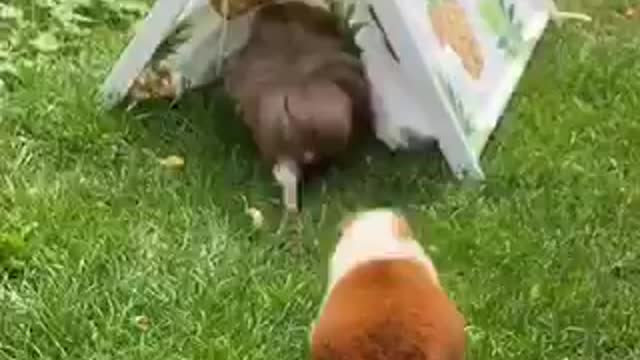Premium Only Content

Pucky The Guinea Pig Adventures | Part 4
Pucky This little piggy… isn’t a pig at all! Guinea pigs, also called cavies, are stout little rodents from various regions of South America. The best known of this family is the domesticated guinea pig (Cavia porcellus) that is commonly kept as a pet, and is broken down into approximately 13 breeds.
It’s believed that the Incas domesticated guinea pigs more than 3,000 years ago, and Spanish explorers brought guinea pigs back from the Andes of South America to Europe, where they were kept as exotic pets. The other members of the genus Cavia can still be found in the wilderness across the continent.
So where did the name “guinea pig” come from? Theories include that one guinea was the cost of one in 16th century England; the name could reflect on the squealing sound the rodents make; or that their meat is similar in taste to suckling pig. It’s also possible that ships leaving the port of Guiana in South America or Guinea in West Africa may have transported the rodents to Europe and the name stuck.
The extended family. Guinea pigs are more distantly related to the rodents in the genera Microcavia, Galea, Hydrochoerus, Kerodon, and Dolichotis; which include other cavies, capybaras, and maras. The greater capybara Hydrochoerus hydrochaeris, for example, is the largest rodent in the world.
A family resemblance. While the various types of cavy differ in size, there are some shared characteristics: a stout body, a short tail, a large head with short ears, and continuously growing, flat-crowned jaw teeth (20 of them). Their dense, coarse coat ranges from olive-, cinnamon-, and reddish-brown to yellowish-gray. Some, such as the greater guinea pig (C. magna) sport shiny black streaks down their backs. Underparts are usually whitish to gray. The soles of their feet are hairless and claws are sharp. When it comes to domestic guinea pigs, a range of colors, hair length, and coat texture are possible.
HABITAT AND DIET
Savanna to scrub. Cavies are found across the South American continent, in open areas ranging from moist savannas to thorn forest and scrub desert. They live in low elevations right up to 16,000 feet (5,000 meters). It’s almost any port in a storm for the cavy—grasslands, forest margins, swamps, and rocky areas are all home, sweet home to some cavies. Their range runs from Venezuela to southern Patagonia, but they are not found in western Chile or most of the Amazon River basin.
Anybody home? If cavies don’t “dig” their home, they find the home of other wildlife that have moved out. They den at night in burrows that they have excavated or that other mammals have abandoned. Some also find shelter in dense vegetation, in rock crevices, or under brush piles.
A day in the life. Cavies are terrestrial and colonial, active during the day (diurnal) or during early morning and evening (crepuscular). These social rodents are herd animals and stick together when feeding or grooming. Quite expressive, guinea pigs communicate via chirps, purrs, rumbling, and squealing.
A link in the chain. Cavies certainly play a role in keeping their ecosystems running—they mainly eat plant material, but are prey for various mammals, birds of prey, reptiles such as anacondas and caimans, and even humans. Guinea pigs' meat is a part of people’s diets in some areas of South America. The rodents’ docile nature also makes it a common subject for research.
Eat those greens. Cavies chow down on whatever vegetation they can find—grasses, leaves, and fruit. At the Zoo, the guinea pigs’ diets include greens, root vegetables, and hay. Veggies, hay and high-fiber herbivore feed are on the menu for capybaras and maras.
FAMILY LIFE
Lots of little ones. Male cavies are called boars and females are called sows. Following a gestation period of about two to three months, the sow gives birth to a litter of pups. While the average litter includes 3 or 4 babies, as many as 13 babies is not unheard of, especially with domesticated guinea pigs. Though pups nurse for nutrition, they can also eat solid food as soon as they are born. At three weeks, the babies are weaned, and they are fully mature in two to three months.
CONSERVATION
Status. We use the following terms, based on the International Union for Conservation of Nature (IUCN) Red List of Threatened Species: Extinct, Extinct in the Wild, Critical Risk, Endangered, Vulnerable, Lower Risk.
Four species of guinea pig—Brazilian, montane, shiny, and greater—are of least concern. There is insufficient data for the Sacha guinea pig, and the Santa Caterina’s guinea pig (or Moleques do Sul guinea pig) is critically endangered, due mainly to the fact that the population of fewer than 50 individuals lives in a small area of Serra do Tabuleiro State Park on Moleques Island do Sul, in the State of Santa Catarina, Brazil. People have free access to the island and protected area enforcement is not strict.
-
 2:37:43
2:37:43
Flyover Conservatives
1 day agoDR. KIRK ELLIOTT | Deep Dive: Tariffs, Tech, and Total Economic Warfare – Who Wins and Who Loses? | In Studio - FOC Show
73.9K4 -
 3:12:37
3:12:37
Danny Polishchuk
13 hours agoTariffs and Trade Wars + Nick Rochefort | Low Value Mail #136
59K3 -
 2:04:40
2:04:40
I_Came_With_Fire_Podcast
15 hours agoCartels vs The United States, Fentanyls 2 Front WAR, and FTOs
31.2K -
 4:54
4:54
CryptoWrld
15 hours ago $1.94 earnedCrypto Startup Launches Tokenized US Treasury Bonds
31.1K4 -
 2:29:15
2:29:15
We Like Shooting
21 hours ago $1.25 earnedWe Like Shooting 596 (Gun Podcast)
22.5K -
 54:43
54:43
Kimberly Guilfoyle
14 hours agoThe Trump Effect: Mexico Folds, Live with Dinesh D’Souza & Chuck DeVore | Ep.193
107K34 -
 1:20:47
1:20:47
Redacted News
13 hours agoMexico CAVES to Trump over tariffs, USAID Shutdown, & Zelensky loses $200 billion | Redacted Live
188K468 -
 1:02:29
1:02:29
The StoneZONE with Roger Stone
10 hours agoIs GOP Sen. Bill Cassidy Playing Politics with RFK Jr. Vote as U.S. Faces Public Health Crisis?
37.5K5 -
 1:10:30
1:10:30
BIG NEM
13 hours ago📢 THE JOLLOF-OFF: The Battle for West African Cuisine! 🇳🇬🔥🇬🇭
31.8K4 -
 54:58
54:58
LFA TV
1 day agoThe Trade War Begins | TRUMPET DAILY 2.3.25 7pm
57.2K27